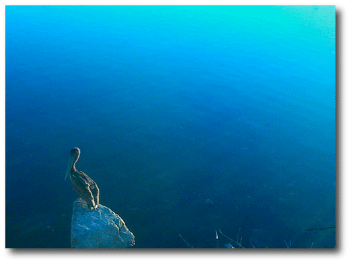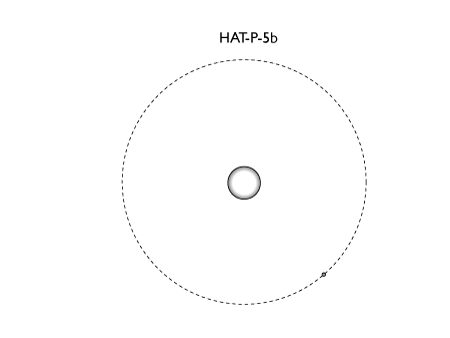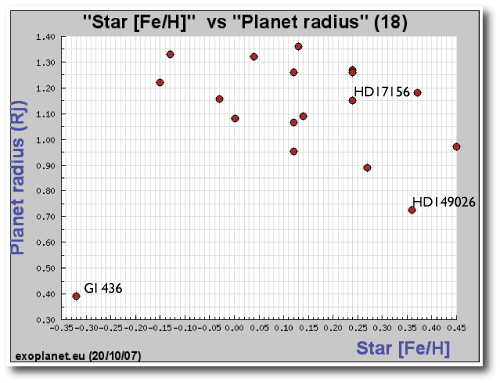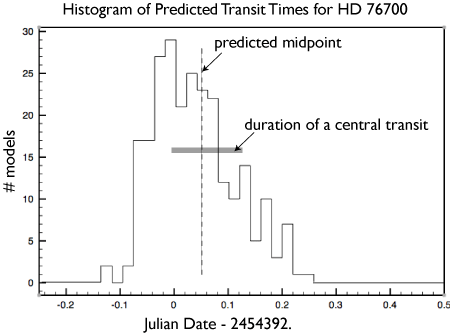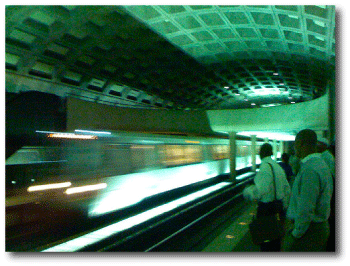
Image Source.
I’m happy to report that HD 17156b is observable in transit, and that Transitsearch.org observers played the key role in the discovery.
Regular oklo.org readers are familiar with HD 17156 b. This planet has an orbital period of 21.2 days, which is nearly four times longer than any other known transiting planet, and an eccentricity of e=0.67 (even higher than HAT-P-2b’s eccentricity of e=0.5). The geometry of the eccentric orbit has a periastron angle of 121 degrees, which means that the planet is quite close to the star as it perforates the plane containing the line of sight to Earth. Here’s a scale model showing the planet (at equally spaced intervals), the star, and the orbit:
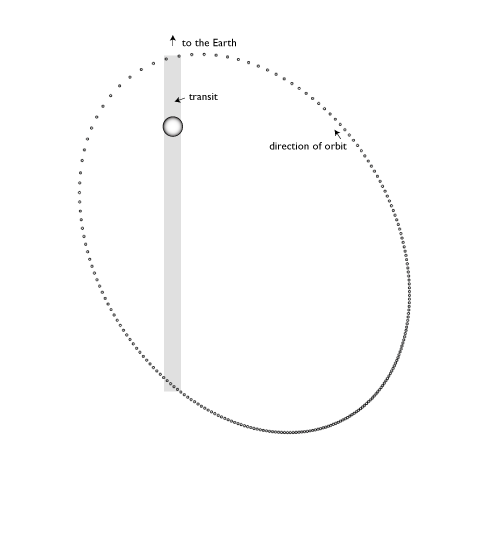
Early last week, I got e-mail from Mauro Barbieri, an Italian post-doctoral researcher who is working on the CoRoT satellite, and who’s based at LAM in Marseille, France. In his spare time, Mauro has been writing articles for popular astronomy magazines in Italy, and has worked to coordinate Italian amateur astronomers for participation in Transitsearch campaigns. On the night of Sept. 9/10, he recruited four Italian amateur astronomers to monitor the transit window.
Two observers in Northern Italy were clouded out prior to the start of the transit, but two others, D. Gasparri and C. Lopresti, were able to observe through much of the night in Central Italy. Their data looked promising, showing clear ingresses at the same time as the ingress was observed by Jose Almenara in the Canary Islands. Ron Bissinger, observing from Pleasanton, California, and seven hours farther west, was able to start observing just after the transit ended.
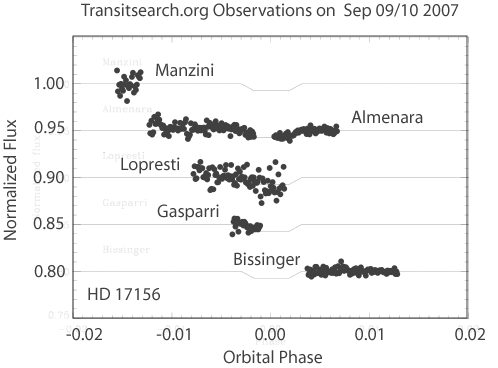
As it happened, Roi Alonso, another CoRoT postdoc, is good friends with Jose Almenara, who made the Canary Island observations on Sep 9/10. Barbieri and Alonso did a careful analysis of the three transit-bearing data sets, and concluded that the transit is present at 3-sigma, 5.3-sigma, and 7.9-sigma, respectively. Almenara’s data, in particular, is excellent, despite of the fact that high winds occluded part of the mid-transit time series. By last Friday, on the strength of the detections, we had begun drafting a paper that discusses the discovery.
The Almenara egress is particularly convincing (the bottom time series shows the result of subtracting out the best-fit transit signal):
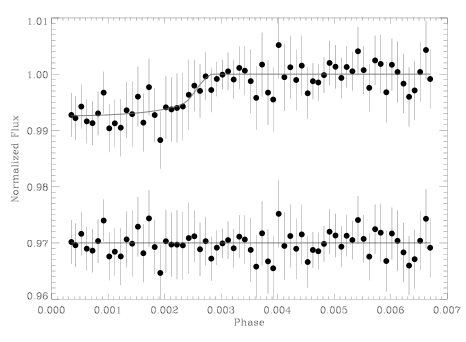
Barbieri’s and Alonso’s fit to the data from Sep. 9/10 implies the following properties for the planet and the transit. The model consistently takes into account the eccentric character of the planetary orbit:
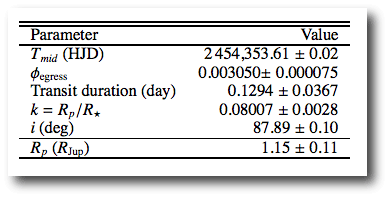
The fit to the data suggests that the radius of HD 17156b is just a bit larger than the radius of Jupiter. This is fully in line with our theoretical models of the planet. HD 17156b experiences strong tidal forces during its periastron passages. This tidal heating might be observable in the form of excess infrared radiation, but it is not serving to inflate the planet beyond its expected radius.
Needless to say, we were quite excited by the quality of the fit. Everything seemed to hang together quite well, but confirmation was essential. The full transit would be visible across the United States and Canada. I wrote to the transitsearch.org mailing list, urging observers to monitor the star through the night of Sep. 30/Oct. 1. Dave Charbonneau of Harvard had been following oklo.org, and was impressed by the Sep 9/10 data. He worked very hard to organize and coordinate observers, and he’ll be leading a follow-up paper that uses data from all the transits to improve the planetary and the orbital characterization. Dave was very generous in offering to notify us if a transit was confirmed by the cadre of observers that he’d recruited.
Sunday morning was perfectly clear in Santa Cruz. Ron Bissinger lives in Pleasanton, just forty miles to the Northeast, and was ready to observe. His pipeline is quite automated, and so if he could observe, I knew that we would rapidly rule out or confirm a transit.
Late Sunday afternoon, I went running, and noticed that a gloomy bank of clouds was visible over the Pacific to the west:
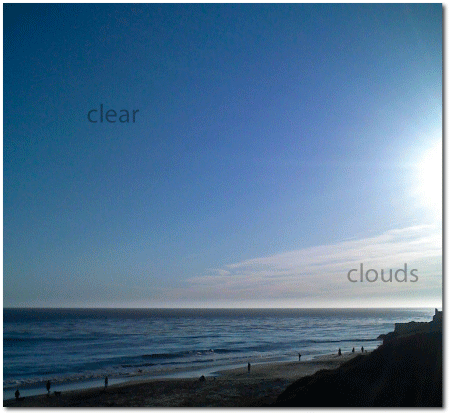
At dusk, it was still clear, but the weather forecast did not look good. The bands of clouds that had stayed offshore to the Northwest were beginning to slide across the skies. By midnight, it was evident that the Bay Area would not be producing useful photometry. Furthermore, all of Arizona and New Mexico were rained out. Observer after observer reported in to say that they had not gotten data. The only positive report of clear skies came from Dave, graduate student Philip Nutzman, and postdoc Jonathan Irwin, who had set up a small telescope on the roof of a Harvard/CfA building in Cambridge MA.
By Monday morning, however, it was clear that several observers had indeed managed to obtain data. In addition to the Harvard roof observations, Bill Welsh and Abhijith Rajan had obtained usable photometry from the Mt. Laguna Observatory run by San Diego State University. Dave reported to me that on Sunday, while Dave was visiting the Zoo with his daughter, Bill had called with the news that they had managed to secure a night on the telescope and were at that moment driving up the mountain. In addition, a report came from Tim Brown of Las Cumbres observatory that while their Hawaii site had been weathered out, observations had been successfully made from parking lot of the observatory headquarters in Santa Barbara. And in addition, Don Davies, a Transitsearch.org observer in Torrance California had obtained a 10,000 CCD frames under good sky conditions.
On Tuesday evening, I got a phone call from Dave. The transit was clearly visible in both the Cambridge and the Mt. Laguna data. Thirty minutes later, I got an e-mail from Don Davies, who, in the early stages of analysis was seeing a clear transit-like signal at the expected time. We signed on Davies as a co-author, added Dave’s personal communication to the paper draft, and submitted the discovery. The paper will be showing up on astro-ph today. Here’s a link to a .pdf version:
Barbieri et al. 2007, AA, submitted (157 kb)
As for HD 17156b itself, the transit should present a number of exciting opportunities for follow-up observations. The large orbit leads to a 26-fold orbital variation in the amount of flux received from the parent star. This should drive complex weather on the surface, and indeed, even the night side of the planet should be glowing from its own radiation. Here’s a frame from Jonathan Langton’s most recent simulation of the planet which shows the night side hemisphere:
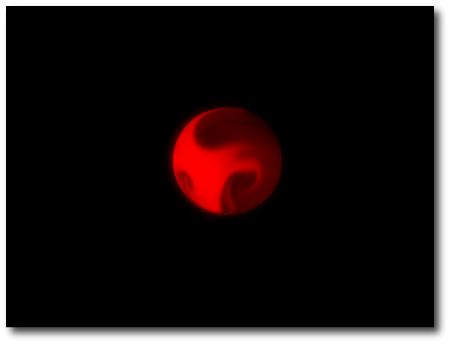
And here’s a one-orbit 1 MB animation of the surface flow patterns, glowing and roiling with their own emitted heat.
